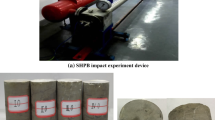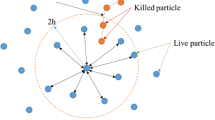Abstract
We use the particle flow code PFC3D to simulate the triaxial compression of sandstone under various radial stresses and loading strain rates to determine the triaxial stress-strain curves, crack propagation path, and contact forces to investigate the failure process of sandstone. We analyze the energy and damage evolution during triaxial compression. The results indicate that the tension and shear-induced cracks increase with the increase of radial stress under the same loading strain rate. Both normal and tangential contact forces exhibit strong anisotropy and increase with radial stress and strain rate. The normal contact force has an approximately symmetrical distribution with respect to the horizontal plane, whereas the tangential contact force has an approximately symmetrical distribution with respect to the axis. For the characteristics of the energy evolution, the boundary energy density, strain energy density, and dissipated energy density all increase linearly with the radial stress, and the boundary energy density increases at the fastest rate, followed by the strain energy density and dissipated energy density. In the post-peak stage the primary energy consumption is the dissipated energy. After that, in the remaining stage the strain energy decreases gradually. By analyzing the evolution of the damage variables in the prepeak area we observed that the damage variable followed an exponential relationship with the axial strain. When the loading strain rate is constant, the damage variable corresponding to the same strain value decreases with increase of radial stress. The results indicate that the increase in radial stress delays the damage acceleration. In contrast, the effect of the loading strain rate on the damage variable is small. The findings reveal the internal structural evolution of rocks during deformation and failure.














Similar content being viewed by others
Data Availability
The data used to support the findings of this study are included within the paper.
References
Chen, Z.Q., He, C., Dong, W.J., Ma, G.Y., Pan, X.Y., Pei, C.Y.: Physico-mechanical properties and its energy damage evolution mechanism of the Jurassic and Cretaceous argillaceous sandstone in Northern Xinjiang. Yantu Lixue 39(8), 2873–2885 (2018). https://doi.org/10.16285/j.rsm.2018.0212 (in Chinese)
Chen, C.F., Xu, T., Zhou, G.L., Qin, T.: Experimental investigation of influence of alternating cyclic loadings on creep behaviors of sandstone. Mech. Time-Depend. Mater., 1–19 (2019). https://doi.org/10.1007/s11043-019-09432-1
Cong, Y., Wang, Z.Q., Zheng, Y.R., Feng, X.T.: Experimental study on microscopic parameters of brittle materials based on particle flow theory. Chin. J. Geotechn. Eng. 37(6), 1031–1040 (2015). https://doi.org/10.11779/CJGE201506009 (in Chinese)
Cong, Y., Cong, Y., Zhang, L.M., Jia, L.X., Wang, Z.Q.: 3D particle flow simulation of loading-unloading failure process of marble. Rock Soil Mech. 40(3), 1179–1212 (2019). https://doi.org/10.16285/j.rsm.2018.0262 (in Chinese)
Cundall, P., Strack, O.D.L.: A discrete element model for granular assemblies. Geotechnique 29, 47–65 (1979)
Du, K., Yang, C.Z., Su, R., Tao, M., Wang, S.F.: Failure properties of cubic granite, marble, and sandstone specimens under true triaxial stress. Int. J. Rock Mech. Min. Sci. 130, 1–15 (2020). https://doi.org/10.1016/j.ijrmms.2020.104309
Feng, F., Li, X.B., Du, K., Li, D.Y., Jamal, R., Wang, S.F.: Comprehensive evaluation of strength criteria for granite, marble, and sandstone based on polyaxial experimental tests. Int. J. Geomech. 20(2), 1–25 (2020). https://doi.org/10.1061/(ASCE)GM.1943-5622.0001544
Gao, F., Cao, S.F., Zhou, K.P., Lin, Y., Zhu, L.Y.: Damage characteristics and energy-dissipation mechanism of frozen–thawed sandstone subjected to loading. Cold Reg. Sci. Technol. 169, 1–9 (2020a). https://doi.org/10.1016/j.coldregions.2019.102920
Gao, L., Gao, F., Zhang, Z.Z., Xing, Y.: Research on the energy evolution characteristics and the failure intensity of rocks. Int. J. Min. Sci. Technol. 30(5), 705–713 (2020b). https://doi.org/10.1016/j.ijmst.2020.06.006
Huang, F., Li, T.Y., Gao, X.Y., Yang, X., Lin, Z.: Study on the macro-micro failure mechanism of granite and its geometry effect under the different conditions of confining pressure by discrete element. J. China Coal Soc. 44(3), 923–932 (2019). https://doi.org/10.13225/j.cnki.jccs.2018.0070 (in Chinese)
Li, W.J., Han, Y.H., Wang, T., Ma, J.W.: DEM micromechanical modeling and laboratory experiment on creep behavior of salt rock. J. Nat. Gas Sci. Eng. 46, 38–46 (2017). https://doi.org/10.1016/j.jngse.2017.07.01310.1016/j.jngse.2017.07.013
Liu, N., Zhang, C.S.: Simulation on influence of different loading rates on Jinping marble in uniaxial compression test by PFC2D. In: Rock Mechanics: Achievements and Ambitions, pp. 327–329 (2012). https://doi.org/10.1201/b11438-64
Liu, X.S., Ning, J.G., Tan, Y.L., Gu, Q.H.: Damage constitutive model based on energy dissipation for intact rock subjected to cyclic loading. Int. J. Rock Mech. Min. Sci. 85, 27–32 (2016). https://doi.org/10.1016/j.ijrmms.2016.03.003
Liu, X.B., He, S.H., Wang, D.H.: Numerical analysis of the anisotropy and scale effects on the strength characteristics of defected rockmass. Adv. Civ. Eng. 2020(5), 1–21 (2020). https://doi.org/10.1155/2020/5892924
Mehrdad, I.I., Hamid, R.N., Kamran, G.: Dynamic response and failure mechanism of Brazilian disk specimens at high strain rate. Soil Dyn. Earthq. Eng. 100, 261–269 (2017). https://doi.org/10.1016/j.soildyn.2017.06.007
Meng, Q.B., Zhang, M.W., Han, L.J., Pu, H., Nie, T.Y.: Effects of acoustic emission and energy evolution of rock specimens under the uniaxial cyclic loading and unloading compression. Rock Mech. Rock Eng. 49(10), 3873–3886 (2016). https://doi.org/10.1007/s00603-016-1077-y
Meng, Q.B., Zhang, M.W., Zhang, Z.Z., Han, L.J., Pu, H.: Research on non-linear characteristics of rock energy evolution under uniaxial cyclic loading and unloading conditions. Environ. Earth Sci. 78(23), 650.1–650.20 (2019). https://doi.org/10.1007/s12665-019-8638-9
Ning, J.G., Wang, J., Jiang, J.Q., Hu, S.C., Jiang, L.S., Liu, X.S.: Estimation of crack initiation and propagation thresholds of confined brittle coal specimens based on energy dissipation theory. Rock Mech. Rock Eng. 51(1), 119–134 (2018). https://doi.org/10.1007/s00603-017-1317-9
Shi, C., Yang, W.K., Yang, J.X., Chen, X.: Calibration of micro-scaled mechanical parameters of granite based on a bonded-particle model with 2D particle flow code. Granul. Matter 21(2), 1–13 (2019). https://doi.org/10.1007/s10035-019-0889-3
Wang, P., Xu, J.Y., Fang, X.Y., Wang, P.X.: Energy dissipation and damage evolution analyses for the dynamic compression failure process of red-sandstone after freeze-thaw cycles. Eng. Geol. 221, 104–113 (2017). https://doi.org/10.1016/j.enggeo.2017.02.025
Wen, T., Tang, H.M., Ma, J.W., Liu, Y.R.: Energy analysis of the deformation and failure process of sandstone and damage constitutive model. KSCE J. Civ. Eng. 23(2), 513–524 (2019). https://doi.org/10.1007/s12205-018-0789-9
Xie, H.P., Ju, Y., Li, L.Y.: Criteria for strength and structural failure of rocks based on energy dissipation and energy release principles. Chin. J. Rock Mech. Eng. 24(17), 3003–3010 (2005) (in Chinese)
Xie, H.P., Ju, Y., Li, L.Y.: Energy mechanism of deformation and failure of rock masses. Chin. J. Rock Mech. Eng. 27(9), 1729–1740 (2008) (in Chinese)
Xing, K., Zhou, Z., Yang, H., Liu, B.C.: Macro–meso freeze–thaw damage mechanism of soil–rock mixtures with different rock contents. Int. J. Pavement Eng. 21(1), 9–19 (2020). https://doi.org/10.1080/10298436.2018.1435879
Yao, W., Cai, Y.Y., Yu, J., Zhou, J.F., Liu, S.Y., Tu, B.X.: Experimental and numerical study on mechanical and cracking behaviors of flawed granite under triaxial compression. Measurement 145, 573–582 (2019). https://doi.org/10.1016/j.measurement.2019.03.035
Yin, D.W., Chen, S.J., Liu, X.Q., Ma, H.F.: Simulation study on strength and failure characteristics for granite with a set of cross-joints of different lengths. Adv. Civ. Eng. 2018(PT.2), 2–9 (2018). https://doi.org/10.1155/2018/2384579
Zhang, Z.Z., Gao, F.: Experimental research on energy evolution of red sandstone samples under uniaxial compression. Chin. J. Rock Mech. Eng. 31(5), 953–962 (2012). https://doi.org/10.3969/j.issn.1000-6915.2012.05.012 (in Chinese)
Zhang, Q., Zhu, H.H., Zhang, L.Y.: Studying the effect of non-spherical micro-particles on Hoek–Brown strength parameter \(m_{\mathrm{i}}\) using numerical true triaxial compressive tests. Int. J. Numer. Anal. Methods Geomech. 39(1), 96–114 (2015). https://doi.org/10.1002/nag.2310
Zhang, W., Zhou, J., Yu, S.W., Zhang, X.J., Liu, K.: Investigation on contact force and force chain of granular matter in biaxial compression. Chin. J. Appl. Mech. 35(3), 530–538 (2018). https://doi.org/10.11776/cjam.35.03.D045
Zhang, Y.L., Shao, J.F., Liu, Z.B., Shi, C., Géry, D.S.: Effects of confining pressure and loading path on deformation and strength of cohesive granular materials: a three-dimensional DEM analysis. Acta Geotech. 14(2), 443–460 (2019). https://doi.org/10.1007/s11440-018-0671-4
Zhao, Z.L., Jing, H.W., Shi, X.H., Han, G.S.: Experimental and numerical study on mechanical and fracture behavior of rock-like specimens containing pre-existing holes flaws. Eur. J. Environ. Civ. Eng., 1–22 (2019). https://doi.org/10.1080/19648189.2019.1657961
Zhou, T.B., Qin, Y.P., Ma, Q.F., Liu, J.: A constitutive model for rock based on energy dissipation and transformation principles. Arab. J. Geosci. 12(15), 1–14 (2019). https://doi.org/10.1007/s12517-019-4678-4
Acknowledgements
The research was supported by the National Natural Science Foundation of China (51274109). We thank Dr. Shuguang Zhang for technical support.
Author information
Authors and Affiliations
Corresponding author
Additional information
Publisher’s Note
Springer Nature remains neutral with regard to jurisdictional claims in published maps and institutional affiliations.
Rights and permissions
About this article
Cite this article
Zhang, S., Chen, L., Lu, P. et al. Analysis of the energy and damage evolution rule for sandstone based on the particle flow method. Mech Time-Depend Mater 26, 531–546 (2022). https://doi.org/10.1007/s11043-021-09499-9
Received:
Accepted:
Published:
Issue Date:
DOI: https://doi.org/10.1007/s11043-021-09499-9




